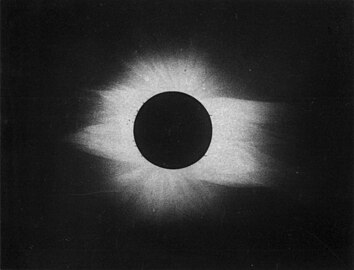Solar eclipse of January 1, 1889
| Solar eclipse of January 1, 1889 | |
|---|---|
| Type of eclipse | |
| Nature | Total |
| Gamma | 0.8603 |
| Magnitude | 1.0262 |
| Maximum eclipse | |
| Duration | 137 s (2 min 17 s) |
| Coordinates | 36°42′N 137°36′W / 36.7°N 137.6°W |
| Max. width of band | 175 km (109 mi) |
| Times (UTC) | |
| Greatest eclipse | 21:16:50 |
| References | |
| Saros | 120 (54 of 71) |
| Catalog # (SE5000) | 9255 |
A total solar eclipse occurred at the Moon's descending node of orbit on Tuesday, January 1, 1889, with a magnitude of 1.0262. A solar eclipse occurs when the Moon passes between Earth and the Sun, thereby totally or partly obscuring the image of the Sun for a viewer on Earth. A total solar eclipse occurs when the Moon's apparent diameter is larger than the Sun's, blocking all direct sunlight, turning day into darkness. Totality occurs in a narrow path across Earth's surface, with the partial solar eclipse visible over a surrounding region thousands of kilometres wide. Occurring about 1.25 days after perigee (on December 31, 1888, at 15:10 UTC), the Moon's apparent diameter was larger.[1]
The path of totality was visible from parts of the modern-day Aleutian Islands of Alaska, California, Nevada, extreme southeastern Oregon, Idaho, Wyoming, Montana, and North Dakota in the United States and south-central Canada. A partial solar eclipse was also visible for much of North America, Hawaii, and the western Caribbean.
Observations and predictions
[edit]-
Path across the western United States and central Canada
-
Drawing by Mabel Loomis Todd
-
Photograph taken from Norman, California
Impact
[edit]Wovoka the Paiute prophet received visions during the solar eclipse of January 1889. These visions were framework for the Pan-Indian religious movement known as the Ghost Dance.[2]
Eclipse details
[edit]Shown below are two tables displaying details about this particular solar eclipse. The first table outlines times at which the moon's penumbra or umbra attains the specific parameter, and the second table describes various other parameters pertaining to this eclipse.[3]
| Event | Time (UTC) |
|---|---|
| First Penumbral External Contact | 1889 January 01 at 19:03:37.4 UTC |
| First Umbral External Contact | 1889 January 01 at 20:23:10.8 UTC |
| First Central Line | 1889 January 01 at 20:24:07.8 UTC |
| First Umbral Internal Contact | 1889 January 01 at 20:25:05.6 UTC |
| Ecliptic Conjunction | 1889 January 01 at 21:08:05.1 UTC |
| Equatorial Conjunction | 1889 January 01 at 21:16:00.1 UTC |
| Greatest Duration | 1889 January 01 at 21:16:12.2 UTC |
| Greatest Eclipse | 1889 January 01 at 21:16:50.0 UTC |
| Last Umbral Internal Contact | 1889 January 01 at 22:08:36.5 UTC |
| Last Central Line | 1889 January 01 at 22:09:32.7 UTC |
| Last Umbral External Contact | 1889 January 01 at 22:10:28.3 UTC |
| Last Penumbral External Contact | 1889 January 01 at 23:30:05.9 UTC |
| Parameter | Value |
|---|---|
| Eclipse Magnitude | 1.02616 |
| Eclipse Obscuration | 1.05301 |
| Gamma | 0.86031 |
| Sun Right Ascension | 18h51m01.4s |
| Sun Declination | -22°56'03.4" |
| Sun Semi-Diameter | 16'16.0" |
| Sun Equatorial Horizontal Parallax | 08.9" |
| Moon Right Ascension | 18h51m03.5s |
| Moon Declination | -22°03'55.3" |
| Moon Semi-Diameter | 16'33.2" |
| Moon Equatorial Horizontal Parallax | 1°00'45.2" |
| ΔT | -6.1 s |
Eclipse season
[edit]This eclipse is part of an eclipse season, a period, roughly every six months, when eclipses occur. Only two (or occasionally three) eclipse seasons occur each year, and each season lasts about 35 days and repeats just short of six months (173 days) later; thus two full eclipse seasons always occur each year. Either two or three eclipses happen each eclipse season. In the sequence below, each eclipse is separated by a fortnight.
| January 1 Descending node (new moon) |
January 17 Ascending node (full moon) |
|---|---|
 |
|
| Total solar eclipse Solar Saros 120 |
Partial lunar eclipse Lunar Saros 132 |
Related eclipses
[edit]Eclipses in 1889
[edit]- A total solar eclipse on January 1.
- A partial lunar eclipse on January 17.
- An annular solar eclipse on June 28.
- A partial lunar eclipse on July 12.
- A total solar eclipse on December 22.
Metonic
[edit]- Preceded by: Solar eclipse of March 16, 1885
- Followed by: Solar eclipse of October 20, 1892
Tzolkinex
[edit]- Preceded by: Solar eclipse of November 21, 1881
- Followed by: Solar eclipse of February 13, 1896
Half-Saros
[edit]- Preceded by: Lunar eclipse of December 28, 1879
- Followed by: Lunar eclipse of January 8, 1898
Tritos
[edit]- Preceded by: Solar eclipse of February 2, 1878
- Followed by: Solar eclipse of December 3, 1899
Solar Saros 120
[edit]- Preceded by: Solar eclipse of December 22, 1870
- Followed by: Solar eclipse of January 14, 1907
Inex
[edit]- Preceded by: Solar eclipse of January 23, 1860
- Followed by: Solar eclipse of December 14, 1917
Triad
[edit]- Preceded by: Solar eclipse of March 4, 1802
- Followed by: Solar eclipse of November 3, 1975
Solar eclipses of 1888–1891
[edit]This eclipse is a member of a semester series. An eclipse in a semester series of solar eclipses repeats approximately every 177 days and 4 hours (a semester) at alternating nodes of the Moon's orbit.[4]
The partial solar eclipses on February 11, 1888 and August 7, 1888 occur in the previous lunar year eclipse set.
| Solar eclipse series sets from 1888 to 1891 | ||||||
|---|---|---|---|---|---|---|
| Ascending node | Descending node | |||||
| Saros | Map | Gamma | Saros | Map | Gamma | |
| 115 | July 9, 1888 Partial |
−1.2797 | 120 | January 1, 1889 Total |
0.8603 | |
| 125 | June 28, 1889 Annular |
−0.5431 | 130 | December 22, 1889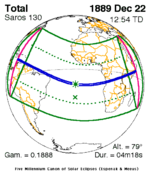 Total |
0.1888 | |
| 135 | June 17, 1890 Annular |
0.2246 | 140 | December 12, 1890 Hybrid |
−0.5016 | |
| 145 | June 6, 1891 Annular |
0.9754 | 150 | December 1, 1891 Partial |
−1.2515 | |
Saros 120
[edit]This eclipse is a part of Saros series 120, repeating every 18 years, 11 days, and containing 71 events. The series started with a partial solar eclipse on May 27, 933 AD. It contains annular eclipses from August 11, 1059 through April 26, 1492; hybrid eclipses from May 8, 1510 through June 8, 1564; and total eclipses from June 20, 1582 through March 30, 2033. The series ends at member 71 as a partial eclipse on July 7, 2195. Its eclipses are tabulated in three columns; every third eclipse in the same column is one exeligmos apart, so they all cast shadows over approximately the same parts of the Earth.
The longest duration of annularity was produced by member 11 at 6 minutes, 24 seconds on September 11, 1113, and the longest duration of totality was produced by member 60 at 2 minutes, 50 seconds on March 9, 1997. All eclipses in this series occur at the Moon’s descending node of orbit.[5]
| Series members 50–71 occur between 1801 and 2195: | ||
|---|---|---|
| 50 | 51 | 52 |
 November 19, 1816 |
 November 30, 1834 |
 December 11, 1852 |
| 53 | 54 | 55 |
 December 22, 1870 |
 January 1, 1889 |
 January 14, 1907 |
| 56 | 57 | 58 |
 January 24, 1925 |
 February 4, 1943 |
 February 15, 1961 |
| 59 | 60 | 61 |
 February 26, 1979 |
 March 9, 1997 |
 March 20, 2015 |
| 62 | 63 | 64 |
 March 30, 2033 |
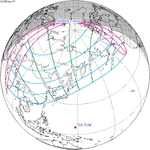 April 11, 2051 |
 April 21, 2069 |
| 65 | 66 | 67 |
 May 2, 2087 |
 May 14, 2105 |
 May 25, 2123 |
| 68 | 69 | 70 |
 June 4, 2141 |
 June 16, 2159 |
 June 26, 2177 |
| 71 | ||
 July 7, 2195 | ||
Metonic series
[edit]The metonic series repeats eclipses every 19 years (6939.69 days), lasting about 5 cycles. Eclipses occur in nearly the same calendar date. In addition, the octon subseries repeats 1/5 of that or every 3.8 years (1387.94 days). All eclipses in this table occur at the Moon's descending node.
| 22 eclipse events between March 16, 1866 and August 9, 1953 | ||||
|---|---|---|---|---|
| March 16–17 | January 1–3 | October 20–22 | August 9–10 | May 27–29 |
| 108 | 110 | 112 | 114 | 116 |
 March 16, 1866 |
 August 9, 1877 |
 May 27, 1881 | ||
| 118 | 120 | 122 | 124 | 126 |
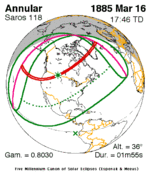 March 16, 1885 |
 January 1, 1889 |
 October 20, 1892 |
 August 9, 1896 |
 May 28, 1900 |
| 128 | 130 | 132 | 134 | 136 |
 March 17, 1904 |
 January 3, 1908 |
 October 22, 1911 |
 August 10, 1915 |
 May 29, 1919 |
| 138 | 140 | 142 | 144 | 146 |
 March 17, 1923 |
 January 3, 1927 |
 October 21, 1930 |
 August 10, 1934 |
 May 29, 1938 |
| 148 | 150 | 152 | 154 | |
 March 16, 1942 |
 January 3, 1946 |
 October 21, 1949 |
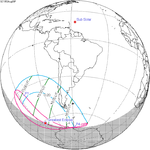 August 9, 1953 | |
Tritos series
[edit]This eclipse is a part of a tritos cycle, repeating at alternating nodes every 135 synodic months (≈ 3986.63 days, or 11 years minus 1 month). Their appearance and longitude are irregular due to a lack of synchronization with the anomalistic month (period of perigee), but groupings of 3 tritos cycles (≈ 33 years minus 3 months) come close (≈ 434.044 anomalistic months), so eclipses are similar in these groupings.
| Series members between 1801 and 2200 | ||||
|---|---|---|---|---|
 September 8, 1801 (Saros 112) |
 August 7, 1812 (Saros 113) |
 July 8, 1823 (Saros 114) |
 June 7, 1834 (Saros 115) |
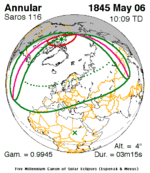 May 6, 1845 (Saros 116) |
 April 5, 1856 (Saros 117) |
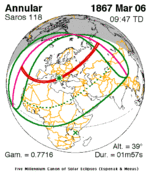 March 6, 1867 (Saros 118) |
 February 2, 1878 (Saros 119) |
 January 1, 1889 (Saros 120) |
 December 3, 1899 (Saros 121) |
 November 2, 1910 (Saros 122) |
 October 1, 1921 (Saros 123) |
 August 31, 1932 (Saros 124) |
 August 1, 1943 (Saros 125) |
 June 30, 1954 (Saros 126) |
 May 30, 1965 (Saros 127) |
 April 29, 1976 (Saros 128) |
 March 29, 1987 (Saros 129) |
 February 26, 1998 (Saros 130) |
 January 26, 2009 (Saros 131) |
 December 26, 2019 (Saros 132) |
 November 25, 2030 (Saros 133) |
 October 25, 2041 (Saros 134) |
 September 22, 2052 (Saros 135) |
 August 24, 2063 (Saros 136) |
 July 24, 2074 (Saros 137) |
 June 22, 2085 (Saros 138) |
 May 22, 2096 (Saros 139) |
 April 23, 2107 (Saros 140) |
 March 22, 2118 (Saros 141) |
 February 18, 2129 (Saros 142) |
 January 20, 2140 (Saros 143) |
 December 19, 2150 (Saros 144) |
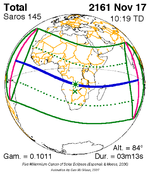 November 17, 2161 (Saros 145) |
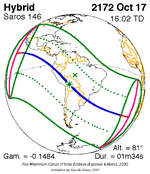 October 17, 2172 (Saros 146) |
 September 16, 2183 (Saros 147) |
 August 16, 2194 (Saros 148) | |||
Inex series
[edit]This eclipse is a part of the long period inex cycle, repeating at alternating nodes, every 358 synodic months (≈ 10,571.95 days, or 29 years minus 20 days). Their appearance and longitude are irregular due to a lack of synchronization with the anomalistic month (period of perigee). However, groupings of 3 inex cycles (≈ 87 years minus 2 months) comes close (≈ 1,151.02 anomalistic months), so eclipses are similar in these groupings.
| Series members between 1801 and 2200 | ||
|---|---|---|
 March 4, 1802 (Saros 117) |
 February 12, 1831 (Saros 118) |
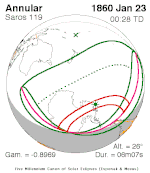 January 23, 1860 (Saros 119) |
 January 1, 1889 (Saros 120) |
 December 14, 1917 (Saros 121) |
 November 23, 1946 (Saros 122) |
 November 3, 1975 (Saros 123) |
 October 14, 2004 (Saros 124) |
 September 23, 2033 (Saros 125) |
 September 3, 2062 (Saros 126) |
 August 15, 2091 (Saros 127) |
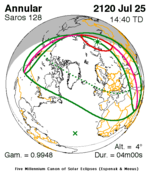 July 25, 2120 (Saros 128) |
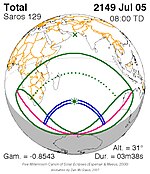 July 5, 2149 (Saros 129) |
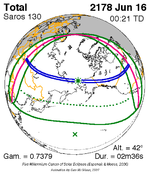 June 16, 2178 (Saros 130) |
|
References
[edit]- ^ "Moon Distances for London, United Kingdom, England". timeanddate. Retrieved 28 August 2024.
- ^ Andrew, Sherry. "Wovoka". apps.lib.umich.edu/. University of Michigan. Retrieved 6 May 2021.
- ^ "Total Solar Eclipse of 1889 Jan 01". EclipseWise.com. Retrieved 28 August 2024.
- ^ van Gent, R.H. "Solar- and Lunar-Eclipse Predictions from Antiquity to the Present". A Catalogue of Eclipse Cycles. Utrecht University. Retrieved 6 October 2018.
- ^ "NASA - Catalog of Solar Eclipses of Saros 120". eclipse.gsfc.nasa.gov.
Further reading
[edit]- Holden, E. S. (1889). "On the solar eclipse of January 1, 1889". The Observatory. 12: 130–134. Bibcode:1889Obs....12..130H.
- Holden, E. S. (April 1889). "On the photographs of the corona at the solar eclipse of 1889, January 1". Monthly Notices of the Royal Astronomical Society. 49 (6): 343. Bibcode:1889MNRAS..49..343H. doi:10.1093/mnras/49.6.343.
- Lockyer, J. Norman (March 1889). "The Total Solar Eclipse of January 1". Nature. 39 (1012): 487–488. Bibcode:1889Natur..39..487L. doi:10.1038/039487b0. S2CID 4097907.
- Payne, William W. (February 1889). "Total Solar Eclipse, Jan 1, 1889". Sidereal Messenger. 8: 64–68. Bibcode:1889SidM....8...64P.
- Pickering, William H. (August 1889). "The Total Solar Eclipse of January, 1889". Sidereal Messenger. 8: 336.1–339. Bibcode:1889SidM....8..336P.
- Pritchett, H. S. (June 1891). "The Solar Corona of January, 1889, from the Photographs". Publications of the Astronomical Society of the Pacific. 3 (16): 155. Bibcode:1891PASP....3..155P. doi:10.1086/120281. S2CID 123421425.
- Taylor, A. (November 1890). "The total solar eclipse of December 21-22, 1889". The Observatory. 13: 348–351. Bibcode:1890Obs....13..348T.
- Todd, Mabel Loomis (1900). Total Eclipses of the Sun. Little, Brown.
- Upton, Winslow; Rotch, Abbott Lawrence; Pickering, Edward Charles (1893). "Meteorological and other observations made at Willows, California, in connection with the total solar eclipse of January 1, 1889". Annals of the Astronomical Observatory of Harvard College. 29 (1). Cambridge: J. Wilson and Son: 1. Bibcode:1893AnHar..29....1U.
External links
[edit]- NASA chart graphics
- Photo of Solar Corona January 1, 1889
- Eclipse of June 1, 1889. Contact print from the original glass negative. Lick Observatory Plate Archive, Mt. Hamilton. [January 1, 1889?!]
- C.E. Watkins photo / eclipse / lick observatory 1889?[permanent dead link], The J. Paul Getty Museum, Object Number: 88.XM.92.83
Text is available under the CC BY-SA 4.0 license; additional terms may apply.
Images, videos and audio are available under their respective licenses.



